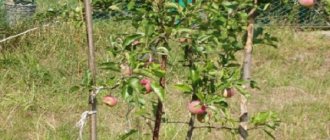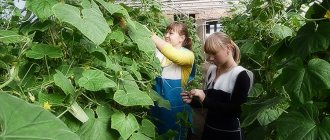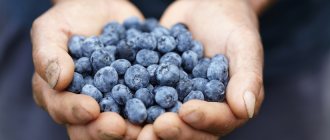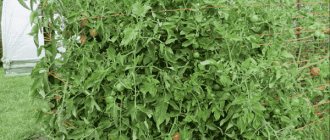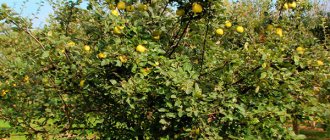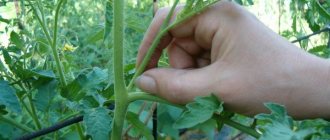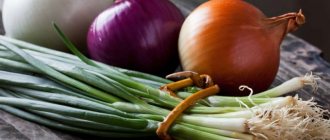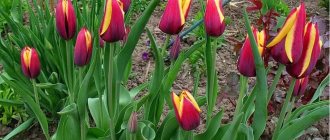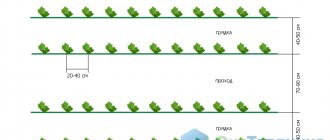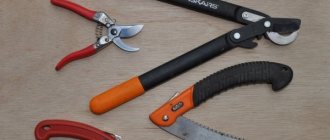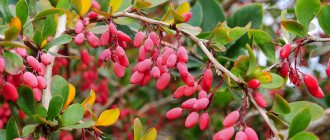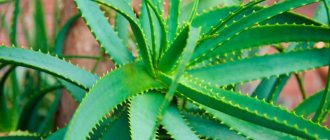What is stepsoning
Pinching is the removal of side shoots growing from the leaf axil (the place between the leaf and the stem) . It is necessary for the formation of healthy vines, full flowering and fruit formation. Stepchildren take away juices and nutrients, preventing the formation of flowers, much less fruits. In addition, pinching cultivates an overgrown plant.
Reference. Proper formation of a bush using pinching increases its level of illumination, redistributes nutrients and minerals, which has a beneficial effect on yield.
Why pick cucumbers?
Cucumbers are climbing plants. Without proper care, plantings become very thick, which limits the flow of sunlight and stops the growth and development of the crop. In addition, in dense plantings, air circulation deteriorates , which leads to rotting of leaves and increases the risk of developing diseases.
Stepped beds are easier to care for and are easier to harvest due to better visibility. Such plantings can bear fruit until late autumn, and the fruits ripen much earlier.
Reference. Cucumbers in an open garden can do without pinching, but greenhouse plantings must be thinned out.
Which varieties do not need to be pinched?
There is an opinion that hybrid varieties of cucumbers do not require pinching. This is not entirely true. Experienced gardeners recommend forming bushes of any cucumbers. In order to increase the yield, the side stems are removed so that the bush develops along the central stem.
Cucumber hybrids that do not need to be planted:
Snowstorm
The variety is grown in open beds and under film. Care consists of loosening the soil, moderate watering, and removing weeds. The hybrid is characterized by early ripening and high fruiting.
Valdai
The early ripening variety has good taste and is resistant to most diseases. It does not require pinching, but there is a need to form bushes.
Petrovsky
The variety is characterized by early ripening, frost resistance and high yield. Form a bush into one trunk.
Northerner
The fruits have excellent taste. The hybrid is resistant to diseases and has high yields.
Gribovchanka
Early ripening hybrid. The fruits are recommended to be consumed fresh. Features of the variety: frost resistance, high yield and lack of bitterness when grown in any weather conditions.
Saratov F1
The high-yielding hybrid is highly resistant to parasites and diseases. They are grown exclusively in open beds.
In the above varieties, cucumbers are formed on the main vine. Shoots from the sides practically do not develop.
When to do it
The timing of pinching largely depends on the time of planting, the growing location (greenhouse or open ground), the condition of the soil, as well as the method of planting - direct or seedlings. General recommendations for pinching time come down to the stages of crop growth.
It is recommended to do the first pinching when the plant has reached 15-20 cm in height . The main branch is determined - the most powerful shoot, and all side shoots are removed by pinching or complete removal from the leaf axil. It is recommended to remove more powerful shoots using pruning shears. The last pinching is carried out before the end of July, depending on the climate.
Recommendations for choosing deadlines
The timing of pinching depends on the degree of plant development. The first time it is carried out 3-4 weeks after planting the seedlings in the greenhouse. By this time, they have already stretched to a height of up to half a meter, and they have formed 5–7 leaf plates. Above them, all the lateral processes are removed, leaving one - the strongest. This is approximately the second half of June.
Early and mid-ripening crop species are planted until the middle of the growing season. Experienced vegetable growers try not to delay pruning in order to reduce the risk of injuring the vine.
Features of pinching cucumbers
Depending on the cultivation method, the features of pinching are determined : different requirements are due to differences in the methods of cultivating plantings. The correct scheme is chosen based not only on the growing method, but also on the characteristics of the plants themselves.
In the greenhouse
Compact varieties that are not prone to abundant growth and do not require frequent pinching are suitable for greenhouses.
Pinching is carried out according to the bush management schemes - in one or several stems. Pinching is carried out in several stages.
How to prolong fruiting
In order for cucumbers to bear fruit longer, remove the leaves that have turned yellow and the stepsons that bear fruit. But you also can’t remove the leaves before the first cucumber. The main stem must be exposed as needed. There should be at least 1-2 leaves under the first cucumber. In order for fruiting to last for a long time, you need to form one strong trunk, remove the stepsons and not pinch the top. As the stem becomes exposed, curl it into loops. But you need to remember that with this method the vegetable will bear fruit longer, but the number of cucumbers will be less than usual.
How to properly pick cucumbers
It is important to carry out the pinching procedure correctly so as not to harm the plant . It is advisable not to allow the stepsons to grow more than 15-20 cm, otherwise it will be difficult to determine which branch is the main one and which is the secondary one: it is easy for an inexperienced gardener to confuse them. The optimal length for pinching is no more than 4-6 cm.
Step-by-step instruction
The general scheme is as follows:
- The leaf with the stepson is pulled in the direction opposite to pinching or cutting.
- The shoot is broken off as close to the stem as possible, being careful not to damage the skin of the leaf or stem.
- When working with a tool, the stepson is cut as low as possible.
Possible schemes
There are several pinching schemes for forming bushes.
The universal scheme is suitable for both self-pollinating varieties and varieties with insect pollination:
- After 4-5 leaves appear, all lower lateral ovaries and stepsons are removed.
- After the formation of the 8th leaf, all side shoots are removed, except one - the top one.
- The next pinching is carried out after 10-11 leaves on the main shoot. Remove all stepsons on the main and side shoots, leaving two side shoots at the tops.
- When the main branch reaches a length of 50-60 cm, break off the top for more competent formation of the remaining side shoots. Small stepsons on all branches are removed.
The scheme for forming a bush into one stem is suitable for plants with insect pollination . This arrangement makes it easier for pollinators to access flowers:
- All side shoots, flowers and ovaries are removed up to the fifth leaf.
- At the level of 6-9 leaves, one ovary is left per internode.
- From the 10th leaf, all stepsons and fruits are left untouched.
Formation into several stems is necessary for varieties whose fruits are set precisely on the lateral branches:
- After the formation of 5-6 true leaves, all stepsons, flowers and ovaries are removed, leaving only one upper stepson - it will later become the second main branch.
- Up to 9-10 leaves are left, one fruit per internode. The main branches are directed in different directions along different supports.
- Further pinching is carried out as the lateral branches grow.
Another scheme is to maintain a bush with two stems . It is almost no different from the multi-stem scheme, except that the stepsons are removed completely after the formation of the second main branch.
Common Beginner Mistakes
Stepping is a simple procedure, but inexperienced gardeners can make serious mistakes:
- Failure to comply with the stepson scheme. Removing each process has specific practical benefits. If you ignore the rules, the process will simply be meaningless.
- Removing shoots. The stepsons pinch off carefully, trying not to damage the remaining parts of the bush. Remove small shoots with your fingers, and sprouted shoots with scissors. The first procedure is best performed using gardening tools.
- Starting time of stepsoning. If the shoots are removed too early, the bush may die. Later pinching will lead to the fact that the shoots will outgrow and it will no longer be possible to remove them.
- No follow-up care. After removing the shoots from the side, the plant must be watered, fertilized and loosened in a timely manner.
Do all cucumbers need to be pinched?
Not all varieties need pinching. To save yourself from this procedure, plant varieties that grow not in vines, but in bushes . Also, hybrids that do not form lateral branches do not need pinching.
The most popular hybrids are:
- Regina Plus F1;
- True friends F1;
- Bouquet F1.
Bunch varieties include:
- Prestige;
- Russian style;
- Petrel;
- Tom Thumb.
Varieties and hybrids that do not require pinching:
- Snowstorm;
- Gribovchkanka;
- Sarovsky F1.
Features of working with varieties
Self-pollinating
Self-pollinating varieties and hybrids are planted according to the following principle:
- remove nodes 1 to 4, leaving no flowers or shoots;
- then, at the 17th node, cut off the buds of the shoots, leaving the ovaries;
- Continue pinching after the second leaf.
When the bushes reach the wire, wrap the main lash twice and lead it to the next bush, pinching the main one.
Pollinated by bees
Cucumbers pollinated by insects are planted according to the classical scheme:
- at the bottom of the stem, tear off the ovaries, flowers and leaves, leaving 3–5 nodes;
- leave the shoots above the 3rd leaf, pinch them as they grow above the first;
- in the axils of 3–4 leaves, save the shoots, pinching them over the second ones;
- Remove the top and leave three nodes on the side of the shoots.
If the stem is too long, it is fixed to the top wire so that it goes down as it grows.
Important! Pinching the bottom part is performed for all varieties. This must be done as early as possible, before the flowers bloom.
Advice from experienced summer residents
Even experienced gardeners will find the advice of their “colleagues” useful:
- It is recommended to plant not only the side shoots, but also the tendrils - they are not needed at the level of 6-7 real leaves.
- The procedure can be carried out by hand, but it is easiest to do the cutting with sharp scissors or garden pruners - this will avoid unnecessary injuries to the plant.
- You should not feel sorry for the stepsons on which ovaries have already formed - they will only take away nutrients from the main ovary and slow down ripening.
- For long-term fruiting, the stepsons are removed along the entire length of the main branch, the crown of which remains intact.
- You should not delay the first planting - early removal of excess shoots will have a beneficial effect on the formation of the root system, which will subsequently feed the entire plant.
- It is better not to remove stepsons whose length has already exceeded 20-25 cm - this will not bring any benefit to the plant. Such a stepson can be left and launched as a side branch.
- For pinching with tools, it is recommended to have separate scissors or pruners. If diseased or old leaves or branches were previously removed with a tool, an infection may be introduced to the wound site. If it is not possible to use a special tool, it is advisable to disinfect the scissors before the procedure by calcining them over a fire or soaking them in a slightly pink solution of potassium permanganate.
How to get an extra harvest in a greenhouse
Proper formation of cucumber plants allows you to harvest a harvest 2–4 times larger from the same area.
However, this agrotechnical technique is effective only if the remaining rules for caring for cucumbers are followed:
- seed material must be of high quality and, if necessary, treated before sowing against infections and for accelerated germination;
- calendar dates and planting patterns (distance between plants) must be observed;
- Regular application of fertilizers is one of the most important factors in increasing crop yields.
How to calculate stepson?
Stepson
Finding a stepson on a cucumber lash is very simple. They form in the leaf axils, that is, in the place where the leaf is attached to the main stem.
Stepchildren are future vines of cucumbers. In other words, if they are not removed, after some time they will develop and will be only slightly thinner than the main stem.
The first stepsons usually appear when the bush grows to 30-40 cm.
Further care of the plant
After growing cucumbers in the greenhouse, you must:
- carry out regular weeding to prevent thickening;
- remove damaged and diseased leaves;
- pinch off barren flowers;
- regulate growth in width;
- provide regular feeding;
- quickly harvest the ripe crop;
- loosen and moisten the soil in a timely manner.
Important!
Watering cucumber bushes should be done only with warm water (it is heated for 24 hours in barrels, buckets, and other containers). If you use direct supply from the water supply, there is a risk of thermal shock, which can destroy even an adult plant.
Necessity of the procedure
What is stepsoning? Stepchildren are called lateral shoots that do not allow the cucumber vine to develop normally. They take away moisture and valuable components needed for fruit formation. Stepchildren are formed between the leaf and the stem. Stepping is getting rid of side branches. They begin to be removed when the plant reaches a height of 6 cm.
For beginners, it is important to know what stepsons are and how to distinguish them from a regular leaf. Lateral shoots appear between the central stem and leaf. First, the leaf itself unfolds, and only then, a little higher, branches are formed. Only the top sprout should be cut off. It is best to plant cucumbers that grow in open beds in mid-July. At this time, the plant will gain enough strength to produce a good harvest.
The answer to the question of whether cucumbers need to be planted is definitely positive. It is necessary to get rid of side lashes, but this must be done carefully. The procedure is not just about removing all excess vegetation. Proper planting of cucumbers involves preserving healthy, strong leaves. They enrich the plant with ultraviolet light and oxygen. Not knowing these features can lead to the death of the crop or a decrease in the number of ripening fruits.
The procedure for forming a stem in cucumbers has a number of positive qualities:
- the number of crops increases;
- fewer weeds appear, so there is no need to weed frequently;
- in rainy summers the likelihood of rotting is reduced;
- the ripened harvest is easy and simple to harvest;
- caring for the beds will not be difficult.
Is it necessary to pick cucumbers of all varieties? Not all varieties of cucumbers will benefit from pinching. Single-stemmed species do not form long stems and therefore do not curl. As they grow, such crops form a neat bush, and the inflorescences are mostly female. Male inflorescences are usually called barren flowers, since they are needed only for pollination.
Most of the male inflorescences need to be removed. Otherwise, the cucumbers will turn out bitter.
It is necessary to remove not only side branches, but also diseased, dry, damaged leaves. Only pinching and clearing of diseased leaves is not carried out on the same day. You should not use the same cutting tools to avoid spreading diseases.
See also
Description of the Farmer cucumber variety, cultivation characteristics and yieldRead
It is recommended to remove them in a timely manner as the mustache appears. They only confuse the plant and prevent it from developing normally. Without them it is easier to see the stepsons.
Second phase
Well-known vegetable grower Oktyabrina Ganichkina recommends applying fertilizer to strengthen the plants before starting the second stage. To do this, it is recommended to use ready-made fertilizers from stores. For example, you can use Giant or Breadwinner fertilizers. After applying fertilizer, each bush should be watered with warm, settled water. It is recommended to spend at least 1 liter of water per plant.
Having finished with the preparatory work, you can begin to remove excess shoots. This pinning scheme is quite simple. It is necessary to begin removing stepsons when 5-8 leaves are fully formed on each bush. At the same time, we must not forget that at the second stage, at least one ovary should be left on the cucumbers.
See also
How to prepare cucumber seeds for planting in open ground and greenhouseRead
During the procedure, it is necessary to pull back the leaf near which the stepson is located and carefully pinch it off. There is no need to rush so as not to accidentally hit the main stem or leaf. When all the work is completed, all the bushes are again tied to the supports.
A few important points when taking stepson
Removing stepsons with scissors
Is it a pity to injure the plant by removing shoots? Cucumbers tolerate the procedure quite painlessly and do not experience stress. But after pruning, it is worth fertilizing the plants and adding some fertilizer. Don’t forget about watering and ventilating the greenhouse.
Additionally, you can spray the lashes with a preparation containing copper, for example, Oxychom. It will protect the plant both internally and externally from many fungal diseases. If fungal spores get into the wound during pinching, then spraying will immediately help destroy them.
When should I stop planting cucumbers? Then, when the entire scheme is completed, the side shoots are removed according to the instructions. But many gardeners advise continuing to control the growth of cucumber vines.
What mistakes should be avoided when stepsoning?
You cannot remove many shoots at once; it will be very stressful for the plant. Do not use dirty tools: scissors or pruners. This can allow dirt and infection to get into fresh wounds. .
Is it worth cutting off the mustache of cucumbers when planting? Some people don’t waste time on such an activity. But some gardeners consider this necessary when growing cucumbers in a greenhouse. Intertwined with each other, the mustaches can make it difficult to process plants.
By accidentally twisting the leaves, they create a secret refuge for pests. You should not rely on the strength of the mustache that holds the plant on a support. The mustache only lasts a month, and after drying it can drop the whip. To prevent this from happening, along with pinching, it is advisable to tie the cucumbers to the support at each new stage.
